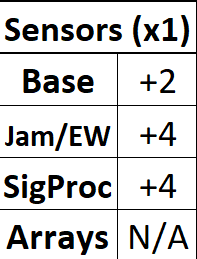Terry Mixon
Emperor Mongoose
My players have a ship with the ability to stealth jump and are about to sneak into an area where they might be detected on emergence from jump space, so I looked at the rules. I'm a little confused.
The drive says: Stealth Jump: A stealth jump drive minimises the burst of radiation caused by the transition from jump space into real space. Normally, a ship that emerges into real space is automatically detected if it emerges within the minimum detail range of the sensor. However, detecting a ship equipped with a stealth drive emerging into real space requires a Formidable (14+) Electronics (sensors) check (1D rounds, INT or EDU) if it is within the ‘limited’ detail range of the sensors or automatically fails if outside the minimum detail range. Stealth jump requires two Advantages.
I'm assuming the detection is for visual sensors, though I didn't find anything to nail that down.
The grade of the sensor will add or subtract a DM:
Basic -4
Civilian Grade -2
Military Grade +0
Improved: +1
Advanced +2
Superior ?? (the ship spreadsheet has TL-16 sensors and the ship the players has is that tech level, but I can read all the text for this one. What would this DM be? +4? Not needed for the others to detect them, but I'm curious.
Looking at the sensor range chart:
Range Visual
Adjacent Full
Close Full
Short Limited
Medium Limited
Long Minimal
Very Long Minimal
Distant None
Those ranges are:
Adjacent 1km or less
Close 1–10km
Short 11–1,250km
Medium 1,251–10,000km
Long 10,001–25,000km
Very Long 25,001–50,000km
Distant More than 50,000km
So, that means it automatically fails at Distant range of 50,000+ km and is a Formidable check at inside the "limited" band 10,000 or less. What about the "minimal" band of 10,001-50,000km? It's not mentioned at all. Would it be an impossible check? Should it also be formidable? Something else? Seems like kind of a glaring (forgive the jump flash pun) omission.
The drive says: Stealth Jump: A stealth jump drive minimises the burst of radiation caused by the transition from jump space into real space. Normally, a ship that emerges into real space is automatically detected if it emerges within the minimum detail range of the sensor. However, detecting a ship equipped with a stealth drive emerging into real space requires a Formidable (14+) Electronics (sensors) check (1D rounds, INT or EDU) if it is within the ‘limited’ detail range of the sensors or automatically fails if outside the minimum detail range. Stealth jump requires two Advantages.
I'm assuming the detection is for visual sensors, though I didn't find anything to nail that down.
The grade of the sensor will add or subtract a DM:
Basic -4
Civilian Grade -2
Military Grade +0
Improved: +1
Advanced +2
Superior ?? (the ship spreadsheet has TL-16 sensors and the ship the players has is that tech level, but I can read all the text for this one. What would this DM be? +4? Not needed for the others to detect them, but I'm curious.
Looking at the sensor range chart:
Range Visual
Adjacent Full
Close Full
Short Limited
Medium Limited
Long Minimal
Very Long Minimal
Distant None
Those ranges are:
Adjacent 1km or less
Close 1–10km
Short 11–1,250km
Medium 1,251–10,000km
Long 10,001–25,000km
Very Long 25,001–50,000km
Distant More than 50,000km
So, that means it automatically fails at Distant range of 50,000+ km and is a Formidable check at inside the "limited" band 10,000 or less. What about the "minimal" band of 10,001-50,000km? It's not mentioned at all. Would it be an impossible check? Should it also be formidable? Something else? Seems like kind of a glaring (forgive the jump flash pun) omission.


